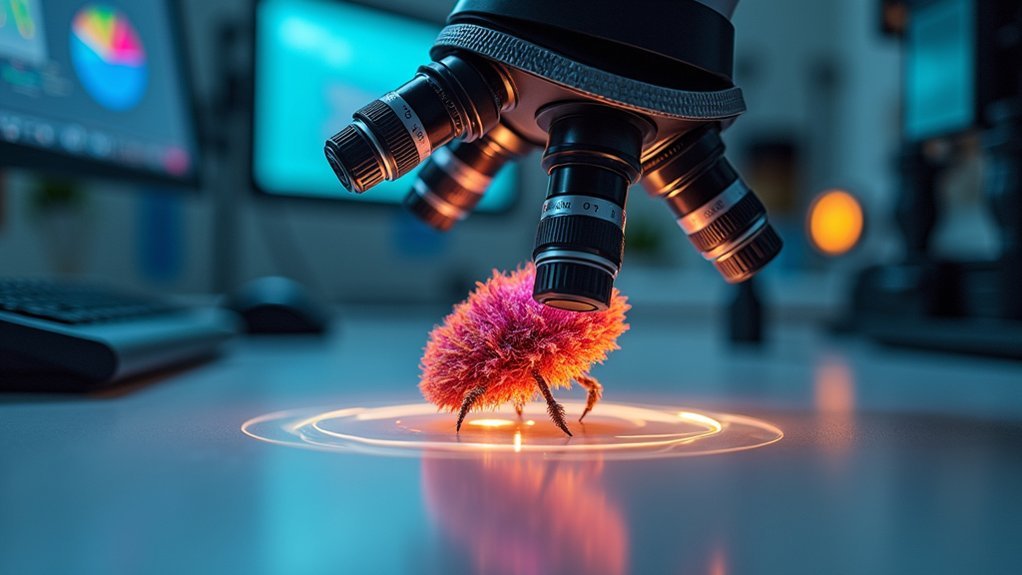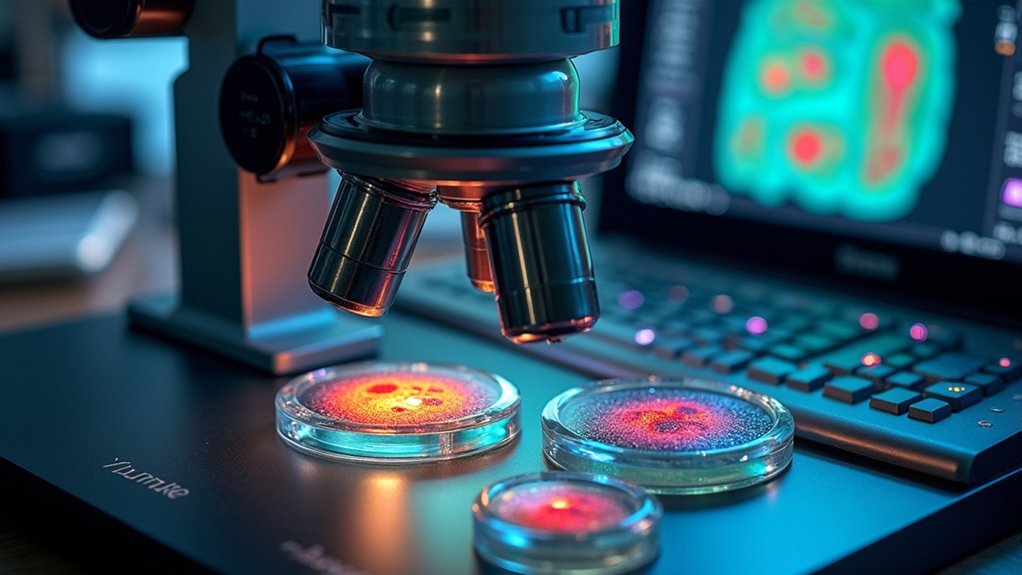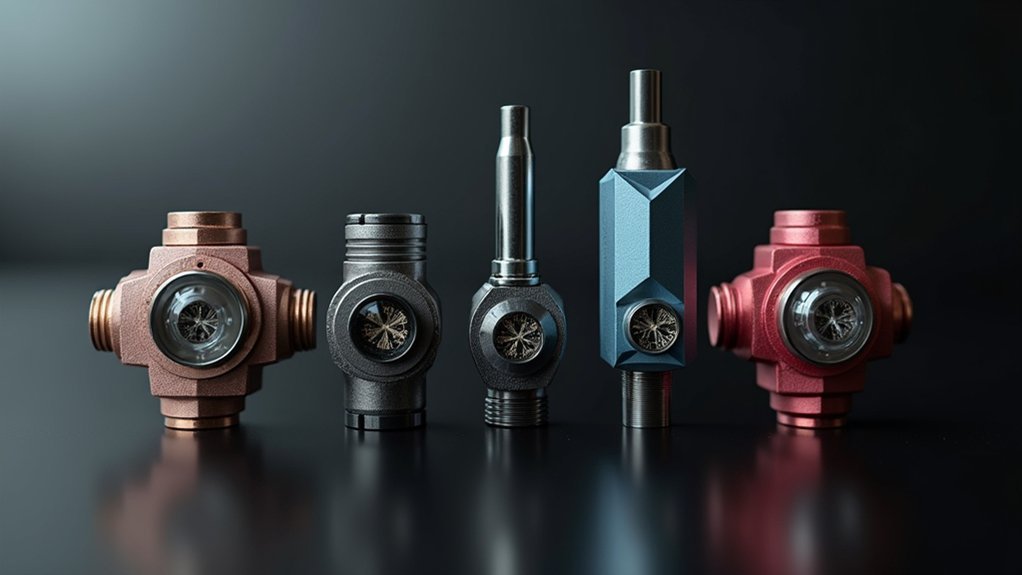For scientific imaging, the top five focus stacking tools are Zerene Stacker with its superior retouching capabilities, Helicon Focus featuring three powerful algorithms, Focus-stack by Petteri Aimonen for free command-line processing, AutoMontage for artifact minimization, and CombineZP offering real-time processing. You’ll find each option balances resolution preservation, artifact handling, and workflow automation differently. Discover which solution best fits your microscopy needs as we explore their specialized features.
5 Best Focus Stacking Tools For Scientific Imaging

When examining specimens at high magnification, you’ll quickly encounter the limited depth of field that plagues scientific imaging. The solution lies in specialized focus stacking programs that combine multiple images into one detail composite image.
Helicon Focus and Zerene Stacker lead the market, offering sophisticated stacking algorithms specifically designed for scientific applications and macro photography. Both handle high resolution images efficiently, with Zerene Stacker particularly valued for its retouching tools that help eliminate unwanted artifacts.
If you’re seeking a free alternative, Focus-stack by Petteri Aimonen offers command-line batch processing while maintaining original resolution. This becomes essential when working with scientific specimens that require hundreds of frames for complete detail capture.
Each tool integrates well with scientific workflows, supporting various image formats for seamless processing.
Professional-Grade Focus Stacking Software for Microscopy
Although optical microscopes provide incredible magnification power, they’re severely limited by their narrow depth of field. Professional focus stacking software like Zerene Stacker and Helicon Focus overcome this limitation by combining thousands of partially focused frames into one high-quality composite image.
| Feature | Zerene Stacker | Helicon Focus |
|---|---|---|
| Frame Capacity | Unlimited | Unlimited |
| Advanced Algorithms | PMax & DMap | Methods A, B & C |
| Retouching Capabilities | Superior | Good |
| Color Profile Handling | Maintains DNG originals | Maintains DNG originals |
| Special Features | Customizable workflows | Panorama stitching, scale overlays |
These tools are essential for scientific imaging where macro focus precision matters. Zerene Stacker excels at extracting fine details, while Helicon Focus offers valuable educational features. Both support the extensive frame counts required for microscopy’s challenging depth of field requirements.
Open-Source Alternatives for Scientific Image Processing

Budget-conscious researchers and scientists need not compromise on image quality when commercial options exceed their financial limitations.
Focus-stack by Petteri Aimonen stands out as a robust open-source alternative for scientific imaging. This command-line tool preserves original image resolution while supporting batch processing critical for research applications.
Though processing takes longer (about 50 seconds per stack), the image quality rivals commercial focus stacking software. You’ll appreciate that it’s completely free, making it a truly cost-effective solution.
You can automate workflows using PowerShell scripts to handle large scientific datasets efficiently.
While the interface requires some technical knowledge, extensive documentation and community support make the learning curve manageable.
For scientists working with limited budgets, focus-stack delivers professional results without the financial burden of premium alternatives.
AI-Powered Stacking Solutions for Research Applications
Modern research demands increasingly sophisticated tools, and AI-powered focus stacking represents the cutting edge of scientific imaging technology. Solutions like Zerene Stacker and Helicon Focus leverage advanced algorithms that analyze multiple images to optimize depth of field and enhance image quality.
| Focus Stacking Program | Key AI Feature | Research Benefit |
|---|---|---|
| Zerene Stacker | Machine learning alignment | Superior detail retention |
| Helicon Focus | Automated focus selection | Increased throughput |
| AutoMontage | Artifact minimization | Enhanced resolution |
| CombineZP | Real-time processing | Faster workflow |
| Affinity Photo | Intelligent blending | Complex macro imaging |
You’ll find these AI-powered stacking solutions particularly valuable for high-volume scientific imaging, as they automate tedious manual adjustments while delivering superior results. The machine learning techniques employed guarantee more accurate alignment and blending in challenging research environments.
Hardware-Software Integration Systems for Automated Microscopy

Seamless hardware-software integration forms the backbone of today’s automated microscopy systems, transforming how researchers capture detailed focus-stacked images.
You’ll find motorized stages and focus rails working in concert with specialized focus stacking software like Zerene Stacker and Helicon Focus to produce exceptional high-resolution imaging results.
These integrated solutions allow you to program precise movements for capturing thousands of images at microscopic scales. Through scripting and batch processing capabilities, you can automate the entire workflow without manual intervention between sets.
The software’s sophisticated algorithms blend partially focused frames to create composite images with remarkable clarity.
Whether you’re using commercial or custom-built systems, the combination of precise hardware control and intelligent software greatly improves repeatability and accuracy in scientific documentation—essential for research in biology and material science.
Frequently Asked Questions
What Is the Best Focus Stacking Program?
For most users, Zerene Stacker is the best focus stacking program due to its reliability, exceptional quality, and extensive control options. If you’re budget-conscious, consider Helicon Focus or the free open-source Focus-stack alternative.
What Equipment Do You Need for Focus Stacking?
You’ll need a camera with manual focus, tripod, focus rail for precision, good lighting, and a computer with focus stacking software. Optional extras include remote triggers and specialized macro lenses for detailed work.
What Is the Best Image Stacker?
The best image stacker depends on your needs. For scientific imaging, Zerene Stacker offers superior control and quality, while Helicon Focus processes quickly. You’ll find Focus-stack great if you’re comfortable with command-line interfaces.
How Much Does a Zerene Stacker Cost?
Zerene Stacker offers three pricing tiers: you’ll pay $39 for the Student version, $189 for the Prosumer edition, or $289 for the Professional edition. You can try it for free before purchasing.
In Summary
You’ve seen the top focus stacking tools available for scientific imaging—from professional microscopy software to open-source alternatives, AI-powered solutions, and integrated systems. Choose the option that best fits your research needs and budget. Whether you’re capturing cellular structures or examining material properties, these tools will help you produce the sharp, detailed images your scientific work demands. Don’t hesitate to experiment with several options before deciding.





Leave a Reply